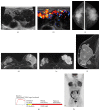Imaging Findings of Plasmacytoma of Both Breasts as a Preceding Manifestation of Multiple Myeloma
- PMID: 26925106
- PMCID: PMC4748066
- DOI: 10.1155/2016/6595610
Imaging Findings of Plasmacytoma of Both Breasts as a Preceding Manifestation of Multiple Myeloma
Abstract
Breast plasmacytoma is an extremely rare tumor. It can occur as a primary isolated tumor or as an extramedullary manifestation in multiple myeloma. This report describes the unusual case of a primary extramedullary plasmacytoma that progressed to multiple myeloma within 15 months in a 35-year-old woman. The patient had been initially diagnosed with a primary extramedullary plasmacytoma of the epidural soft tissue at the cervical 6-thoracic 1 spine level and the stomach. The patient had received chemotherapy and the disease had been in remission. One year later, the disease recurred, affecting both breasts, right clavicle, and orbit. Three months later, the disease had progressed to multiple myeloma. I report this case, focusing on the findings of mammography, ultrasonography, magnetic resonance imaging, and positron emission tomography of bilateral breast plasmacytoma, and provide a review of the literature.
Figures


References
-
- The International Myeloma Working Group. Criteria for the classification of monoclonal gammopathies, multiple myeloma and related disorders: a report of the International Myeloma Working Group. British Journal of Haematology. 2003;121(5):749–757. doi: 10.1046/j.1365-2141.2003.04355.x. - DOI - PubMed
LinkOut - more resources
Full Text Sources
Other Literature Sources

